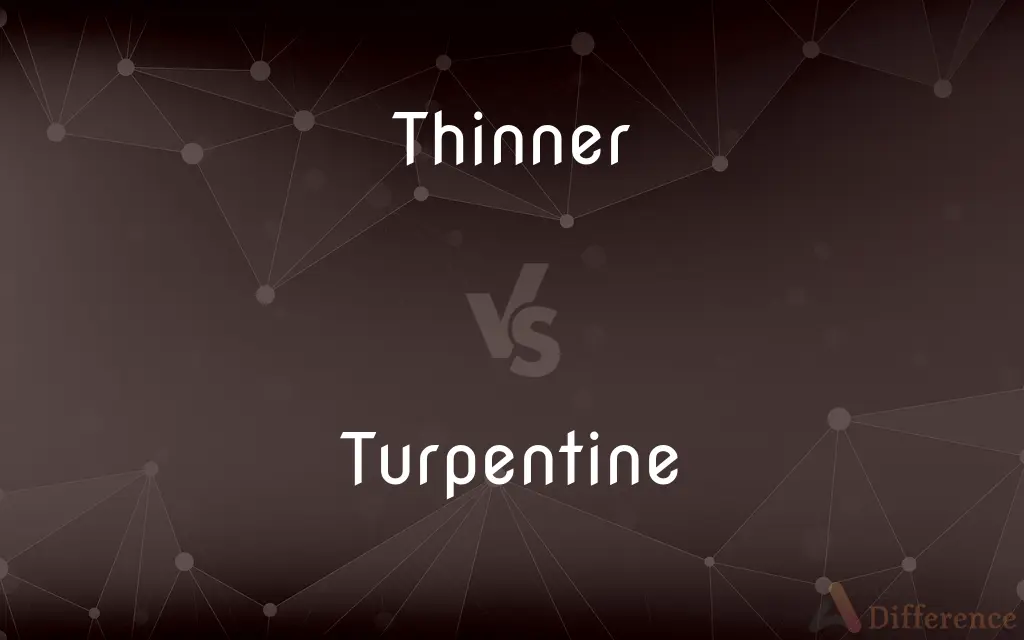Thinner vs. Turpentine — What's the Difference?
Edited by Tayyaba Rehman — By Fiza Rafique — Updated on November 3, 2023
Thinner is a solvent used to dilute paint, while turpentine is a specific type of thinner derived from pine resin.

Difference Between Thinner and Turpentine
Table of Contents
ADVERTISEMENT
Key Differences
Thinner is a broad term for substances used to dilute or reduce the viscosity of paints and other coatings. Turpentine specifically refers to a volatile pungent oil distilled from pine resin, traditionally used as a paint thinner and solvent. While all turpentine can be classified as a thinner, not all thinners are turpentine.
A thinner may encompass a variety of chemical solvents, including turpentine, but also mineral spirits, acetone, and others. Turpentine, on the other hand, has a distinct composition and strong pine scent, and is preferred for its ability to improve paint adherence and its effectiveness with oil-based paints.
When thinning a paint, the type of thinner chosen can affect the drying time and finish of the paint. Turpentine tends to speed up the drying process compared to some other thinners. It is also considered more traditional and natural, but is more volatile and flammable than some synthetic alternatives.
In terms of applications, thinner is used across a variety of mediums and industries, from automotive to artistic, to achieve the desired consistency of paint. Turpentine has a more specialized use, not only as a thinner but also for cleaning brushes and as a raw material in the production of varnishes and other resins.
Comparison Chart
Composition
Varied chemical solvents.
Distilled from pine resin.
ADVERTISEMENT
Use
Diluting various paints.
Traditional oil paint thinner.
Smell
Diverse, often less pungent.
Strong, distinctive pine scent.
Drying Time
Varies by type.
Generally accelerates drying.
Versatility
Wide range of applications.
More specialized applications.
Compare with Definitions
Thinner
Reducing Agent.
The painter added thinner to the oil-based paint.
Turpentine
Brush Cleaner.
She cleaned her brushes with turpentine after painting.
Thinner
Diluent.
The varnish required a special type of thinner.
Turpentine
Oil Paint Diluent.
Mix turpentine into the oil paint to thin it.
Thinner
Solvent.
Use thinner to reduce paint viscosity.
Turpentine
Medium Enhancer.
Artists value turpentine for its effect on paint texture.
Thinner
Liquid Medium.
Thinner is often flammable, so handle it with care.
Turpentine
Resin Distillate.
Turpentine is derived from pine sap.
Thinner
Cleansing Agent.
He used thinner to clean the paintbrushes.
Turpentine
Natural Solvent.
Turpentine has a strong, characteristic smell.
Thinner
A volatile solvent used to make paint or other solutions less viscous
Dampen a clean rag with thinners and carefully wipe any remaining dust from the timber
Turpentine
Turpentine (which is also called gum turpentine, spirit of turpentine, oil of turpentine, wood turpentine, terebenthene, terebinthine and (colloquially), turps) is a fluid obtained by the distillation of resin harvested from living trees, mainly pines. Mainly used as a specialized solvent, it is also a source of material for organic syntheses.
Thinner
A liquid, such as turpentine, mixed with paint or varnish to reduce its viscosity and make it easier to apply.
Turpentine
A volatile pungent oil distilled from gum turpentine or pine wood, used in mixing paints and varnishes and in liniment.
Thinner
A liquid substance used to thin the consistency of another liquid.
Turpentine or mineral spirits can be used as a thinner for oil-based paints.
Turpentine
Any of a number of trees which yield turpentine or a similar resin.
Thinner
Something that thins.
Pomegranate juice and exercise are great natural blood thinners.
The new type of mechanical thinner allowed thinning of peach blossoms to be completed earlier.
A solid mane thinner is indispensable in finishing the looks of your horse.
Turpentine
Apply turpentine to
Antique turpentining equipment
Thinner
One who thins, or makes thinner.
Turpentine
A thin volatile terpenoid essential oil, C10H16, obtained by steam distillation or other means from the wood or exudate of certain pine trees and used as a paint thinner, solvent, and medicinally as a liniment. Also called oil of turpentine, spirit of turpentine.
Thinner
A diluting agent
Turpentine
The sticky mixture of resin and volatile oil from which turpentine is distilled.
Turpentine
A brownish-yellow resinous liquid obtained from the terebinth.
Turpentine
To apply turpentine to or mix turpentine with.
Turpentine
To extract turpentine from (a tree).
Turpentine
Any oleoresin secreted by the wood or bark of certain trees.
Turpentine
A volatile essential oil now obtained from such oleoresin of from the wood of pine trees by steam distillation; a complex mixture of monoterpenes; now used as a solvent and paint thinner.
Turpentine
(transitive) To drain resin from (a tree) for use in making turpentine.
Turpentine
A semifluid or fluid oleoresin, primarily the exudation of the terebinth, or turpentine, tree (Pistacia Terebinthus), a native of the Mediterranean region. It is also obtained from many coniferous trees, especially species of pine, larch, and fir.
Turpentine
Obtained from conifers (especially pines)
Turpentine
Volatile liquid distilled from turpentine oleoresin; used as paint thinner and solvent and medicinally
Common Curiosities
Is thinner always flammable?
Most thinners, including turpentine, are flammable due to their solvent properties.
Does turpentine dry faster than other thinners?
Generally, turpentine speeds up the drying process of oil paints.
What is thinner?
Thinner is any liquid solvent used to thin paint or varnish.
What is turpentine?
Turpentine is a solvent made from the distillation of pine resin.
Does turpentine have a strong odor?
Yes, turpentine has a strong, distinctive pine-like odor.
Can turpentine be used as a thinner?
Yes, turpentine is commonly used as a thinner for oil-based paints.
Can I use any thinner for oil paints?
It's best to use a thinner recommended for oil paints, such as turpentine or mineral spirits.
Is turpentine natural?
Yes, turpentine is a natural product obtained from pine trees.
Can thinner affect the color of the paint?
Generally, thinner should not affect paint color if used properly.
What precautions should I take when using thinner?
Use thinner in a well-ventilated area and keep it away from heat sources.
Are there synthetic alternatives to turpentine?
Yes, there are synthetic solvents like mineral spirits that can be used instead of turpentine.
Can I use turpentine to remove paint from brushes?
Yes, turpentine is effective at cleaning oil-based paint from brushes.
Is water a type of thinner?
Water can act as a thinner for water-based paints, but not for oil-based paints.
Can turpentine be used with acrylic paints?
No, turpentine is not suitable for acrylic paints; it's best used with oil-based paints.
Is turpentine environmentally friendly?
While natural, turpentine production and disposal require care due to its chemical properties.
Share Your Discovery

Previous Comparison
Expedient vs. Expeditious
Next Comparison
Trumpet vs. ClarionAuthor Spotlight
Written by
Fiza RafiqueFiza Rafique is a skilled content writer at AskDifference.com, where she meticulously refines and enhances written pieces. Drawing from her vast editorial expertise, Fiza ensures clarity, accuracy, and precision in every article. Passionate about language, she continually seeks to elevate the quality of content for readers worldwide.
Edited by
Tayyaba RehmanTayyaba Rehman is a distinguished writer, currently serving as a primary contributor to askdifference.com. As a researcher in semantics and etymology, Tayyaba's passion for the complexity of languages and their distinctions has found a perfect home on the platform. Tayyaba delves into the intricacies of language, distinguishing between commonly confused words and phrases, thereby providing clarity for readers worldwide.















































